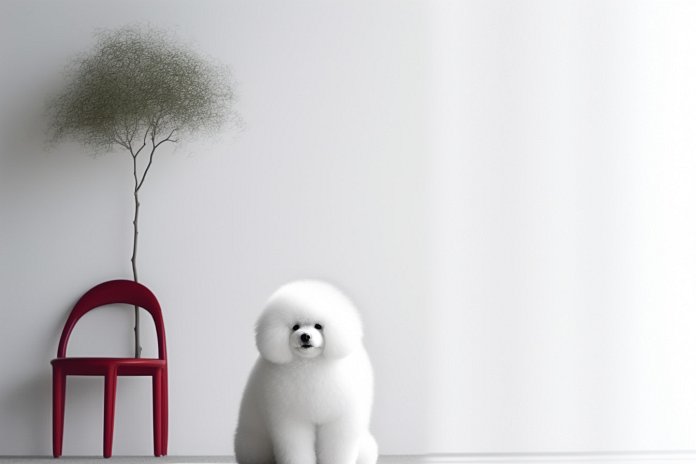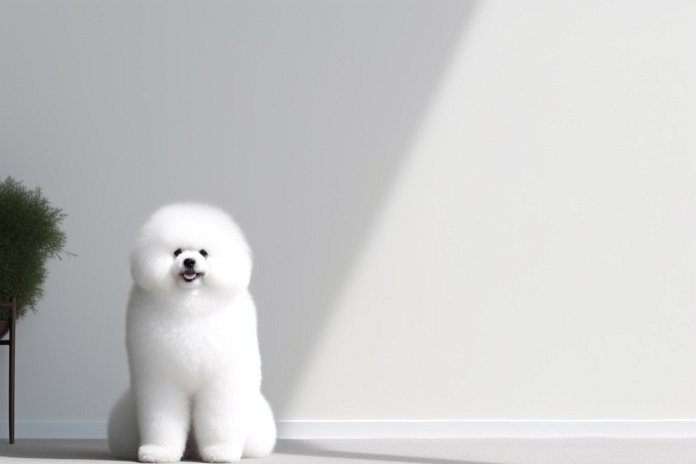
The Bichomo is a small dog breed that is a mix of the Bichon Frise and the American Eskimo. These dogs are known for their tiny size, usually reaching a height of under a foot. Despite their small stature, they are not very inactive and can live comfortably in apartments or compact homes as long as they get enough exercise. They only require about 30 to 45 minutes of exercise per day.
One great advantage of the Bichomo is that they have minimal drooling and odor. They are also hypoallergenic, making them suitable for people with allergies. Additionally, they do not shed much, which means less hair to clean up around the house. This hybrid breed is known for its devotion and makes a wonderful watch dog. However, due to their small and adorable appearance, they are not suitable as guard dogs.
Ahead, we look at Bichomo dog breed, its history, personality, pros and cons of owning an Bichomo, characteristics, and must-see facts. We will also examine how to care for this breed and a lot more. Prepare for a tail-wagging adventure into the world of Bichomos!
| Dog Breed | Bichomo |
| Size | Small |
| Weight | 12-20 lbs (average) |
| Height | 9-12″ (average) |
| Location | United States |
| Ancestry | American Eskimo, Bichon Frise |
| Date of Origin | Bred recently |
| Group | Companion |
| Life Expectancy | 11-15 years |
| Price | $700 – $1000 |
| Family | Canidae |
| Scientific Name | Canis Lupus Familiaris |
📖 Breed History
The Bichomo is a hybrid breed with a short history. While the exact origins of this breed are unknown, its parent breeds, the Bichon Frise and the American Eskimo, have well-documented histories. The Bichon Frise has been around since the 13th century and is believed to have descended from the Poodle and the Barbet Water Spaniel. It was brought to various parts of the world by Spanish Sailors and gained popularity among the French royal courts in the 16th century. In the 19th century, they became circus dogs and beloved pets of organ grinders. After World War I, their numbers declined, but efforts were made to stabilize the breed.
On the other hand, the American Eskimo is a member of the Spitz family of Nordic breeds. Originally known as the German Spitz, the breed underwent a name change due to anti-German sentiments during World War I. It was renamed the American Eskimo Dog, as it was registered in the United Kennel Club by Mr. and Mrs. F. M. Hall in 1913, who named their kennel the American Eskimo. Although they are now considered a separate breed, they are closely related to the German Spitz.
The Bichomo is a recent creation resulting from the intentional breeding of the Bichon Frise and the American Eskimo. Both parent breeds are known for their intelligence and talent.

🐕 Bichomo Appearance
Bichimos are canines that will inherit physical traits from their parents’ respective breeds. They will have small, robust bodies, round heads with a distinct stop leading to a medium-sized nose, and solid look. Their tails will either be more tightly curled or have a sickle-curve. These adorable puppies will have short legs and long bodies. Their black noses have wide nostrils, and their warm, attentive eyes are round. These canines have silky smooth ears that are either curled over at the top or hanging on the sides of their faces. They will have thick, velvety, medium-length coats, and their teeth will come together in a scissors bite. The fur will be light-wavy or curly and be either white or cream in hue. We may look at the looks of the American Eskimo and the Bichon Frise to get a better idea of how this breed would look.
| 👀 Eye Color | Varies |
| 🐽 Nose Color | N/A |
| 🐕 Coat Color | Ranges |
⚡ Fun Fact: Bichomo dogs need a lot of social interaction. They desire to always be with someone or around people. This breed hates being left alone.
🐶 Traits & Temperament of Bichomo
We are reviewing and looking at the data related to the temperament, behavior, and traits of this dog breed. Please stay tuned for our update available shortly.
🤝 Are Bichomos Friendly or Aggressive?
Bichomo dogs are known for their friendly nature towards other pets, strangers, and children. They are generally a good choice for families with kids, as they are kid-friendly and also get along well with cats. Bichomo dogs are very sociable and dog-friendly, making them a great choice if you want to have multiple dogs or participate in dog meetups. Additionally, they are often recommended for elderly people, as they can provide companionship and are well-suited for their needs.
This breed is known for being:
- Playful
- Independent
- Energetic
- Protective
- Alert
- Sensitive
- Intelligent
- Friendly
- Affectionate
- Gentle
- Cheerful
🐩 Bichomo Care & Maintenance
It will be crucial to wipe out this breed’s flopped-down or drooping ears once a week. Be cautious to look for any odd scents or discharge while cleaning them. Despite the fact that they don’t shed much, they nevertheless need to regularly maintain their coats. To maintain their coats tidy and free of knots and dirt, give them a thorough grooming two times each week. Only bathe the Bichomo when absolutely required since frequent bathing might strip its coat of its natural defense oils. These dogs will require frequent tooth brushing, just like all other breeds. At the absolute least, once or twice a week, but every day is ideal. When required, which is usually once or twice a month, trim your pet’s nails. If they tire on their own, your dog could need this less frequently, but if you hear them clicking on the floor as they walk, they are obviously past time.
Bichomo dogs have a higher than average amount of shedding, which is a normal part of their hair growth cycle. The extent and frequency of hair loss can vary depending on the dog’s overall health and breed. If you prefer not to frequently clean up dog hair, you may need to think twice about getting a Bichomo puppy. Additionally, these dogs typically require a bath every 3-4 weeks.
🍖 Food: We recommend few cups daily, costing you about $0.49 – $1.49 daily, or approximately $30.00 a month.
🐾 Exercise: Bichomo dogs have an average exercise need. This breed is satisfied with short walks every weekday and a long ones on weekends.
This dog breed requires to be walked for roughly few miles per week, which equates to about 15 – 35 minutes of physical activity daily. This consistent moderate exercise regimen will help maintain their physical wellness and significantly contribute to their mental stimulation. Consciously setting aside this time for your furry friend can dramatically enhance their life quality, helping them stay energetic, healthy, and mentally alert.
Did you know: Bichomo dogs have a higher energy level than other dog breeds. If you want a dog for snuggling on the couch, this breed isn’t the perfect choice for you.
❤️🩹 Bichomo Health & Issues
Some of the major concerns for Bichomo Dog Breed can be:
- Patellar Luxation
- Intervertebral Disc Disease
- Hip And Elbow Dysplasia
- Pancreatitis
While minor concerns include:
- Bloat
- Obesity
🤧 Important: Is Bichomo hypoallergenic? No.
✨ Bonus: Check out cool, creative, and funny names for Bichomo.
⚡ Bichomo Dog Breed Facts
What makes the Bichomo a great choice for families with young children?
The Bichomo is a great choice for families with young children because they are small and gentle. Their size makes them less likely to accidentally knock over or harm a small child.
Is the Bichomo breed considered a suitable breed for apartment living?
Yes, the Bichomo breed is considered a suitable breed for apartment living. They are small in size and do not require a large amount of space to move around. As long as they get enough exercise, they can adapt well to apartment living.
How much exercise does a Bichomo require compared to other breeds?
The Bichomo requires between 30 and 45 minutes of exercise per day, which is moderate compared to some other breeds. This makes them a good choice for individuals or families who may not have a lot of time for long walks or intense exercise routines.
Is the Bichomo breed known for being good with other pets?
The Bichomo breed is generally known to be good with other pets. However, as with any breed, proper socialization and introductions should be done to ensure a positive relationship between the Bichomo and other pets in the household.
What are other low-maintenance dog breeds similar to the Bichomo?
Some other low-maintenance dog breeds similar to the Bichomo include the Maltese, Shih Tzu, and Pomeranian. These breeds also have minimal shedding and grooming needs.
What are the common health issues that Bichomos are prone to?
Bichomos are generally healthy dogs, but they can be prone to certain health issues. These can include dental problems, allergies, and luxating patella (knee joint dislocation). Regular veterinary check-ups and proper care can help prevent or manage these issues.
Are Bichomos known to be easy to train compared to other breeds?
Bichomos are known to be intelligent and eager to please, making them relatively easy to train. Consistent positive reinforcement methods work well with this breed.
Are Bichomos more prone to separation anxiety compared to other breeds?
Bichomos can be prone to separation anxiety if not properly trained and socialized. Like many small breeds, they can become overly attached to their owners and may experience distress when left alone for long periods of time.
Are there any dog breeds similar to the Bichomo that are suitable for people with allergies?
Yes, there are other dog breeds similar to the Bichomo that are suitable for people with allergies. Some examples include the Bichon Frise, Maltese, and Poodle, all of which are hypoallergenic and have minimal shedding.
What sizes of dogs similar to the Bichomo are best for individuals or families with limited space?
Dogs similar in size to the Bichomo, such as the Maltese and Shih Tzu, are best for individuals or families with limited space. Their small size allows them to comfortably live in apartments or smaller houses.
Is the Bichomo breed known to be good with children with special needs?
The Bichomo breed is generally known to be good with children, including those with special needs. However, as with any dog, supervision and proper introductions should be done to ensure the safety and well-being of both the dog and the child.
How does the grooming and shedding needs of the Bichomo?
The grooming and shedding needs of the Bichomo are relatively low compared to some other breeds. They have hair rather than fur, which means they do not shed as much. Regular brushing and occasional professional grooming will help keep their coat clean and tangle-free.
We use reliable and publicly available data and resources such as AKC and American Canine Registry to ensure that Bichomo dog breed information is accurate and up to date. If you spot an error, please don’t hesitate to bring it to our attention.